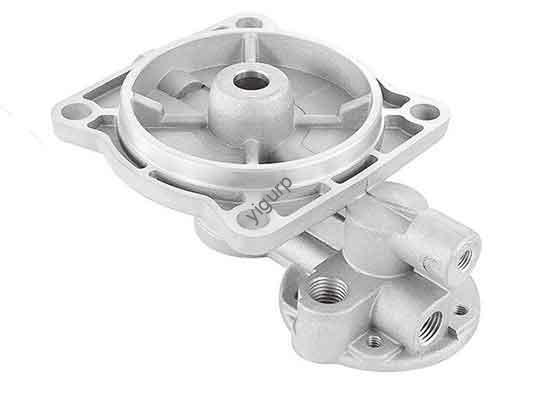If you’re developing prototypes or small-batch parts in Singapore, Casting a vuoto (also called urethane casting) è un punto di svolta. It uses a vacuum to draw liquid resin into silicone molds, creating high-precision parts that mimic production-grade materials—faster and cheaper than injection molding. For local businesses, it cuts R&D time by up to 50% and slashes tooling costs to 20-30% of traditional methods . Che tu sia in automobile, elettronica, o dispositivi medici, it bridges the gap between prototypes and market-ready products.
How Vacuum Casting Works: Una rottura passo-passo
The process is straightforward but requires precision—here’s how Singaporean manufacturers execute it:
- Creazione di pattern master
Primo, a master model of your part is made using 3D Printing O MACCHING CNC. Singaporean shops like RP World often use 3D printing for complex designs, ensuring the master matches your CAD file exactly . The master is inspected for flaws before moving forward.
- Produzione di stampi in silicone
The master is submerged in liquid silicone, which cures around it (in genere 24-48 ore). Once set, the mold is cut into two halves, and the master is removed—leaving a cavity that mirrors your part. These molds last 10-20 usi, a seconda della complessità .
- Casting a vuoto & Polimerizzazione
Resina (PER ESEMPIO., poliuretano) is poured into the mold, which is then placed in a vacuum chamber to eliminate air bubbles (critical for clear or detailed parts). The mold goes into an oven for 3-4 hours of constant-temperature curing . Finalmente, Lo stampo è aperto, and the part gets post-processed (pittura, marcatura laser, ecc.).
Esempio di caso: A global automation firm in Singapore struggled with CNC-machined impeller assemblies that failed underwater tests. RP World switched to vacuum casting: they 3D-printed a master, made a silicone mold, and cast parts that passed long-term underwater trials—cutting production time by half and becoming the client’s long-term supplier .
Key Advantages of Vacuum Casting for Singapore Businesses
Why choose this over 3D printing or injection molding? Here’s how it benefits local teams:
- Velocità: Get 20 parti in 15 days or less —ideal for tight R&D deadlines.
- Efficienza dei costi: Silicone molds cost far less than steel/aluminum injection molds. Per 100 parti, vacuum casting saves 30-60% contro. stampaggio a iniezione .
- Qualità: Parts have superior surface finish (smoother than injection molding) and capture fine details like textures or undercuts .
- Flessibilità: Utilizzo 11+ resin types (PER ESEMPIO., heat-resistant for automotive, transparent for lenses) and add post-processing like screen printing.
Top Materials for Vacuum Casting in Singapore
Singaporean suppliers offer a wide range of resins to match your part’s needs. Here’s a quick guide:
| Tipo di materiale | Proprietà chiave | Usi comuni |
| Hei-Cast PU 8150 | ABS-like rigidity | Recinti, casi |
| Axson PX 5212 | Trasparente, alta chiarezza | Lenti, coperture di visualizzazione |
| Hey-Cast 8752 | Flessibile (simile a una gomma) | Guarnizioni, indossabili |
| High-Temp Resins | Resistenza al calore (fino a 200 ° C.) | Parti del motore automobilistico |
Per la punta: Jucheng Precision, a Singapore-certified (Iso 9001, IATF 16949) shop, recommends Hei-Cast 8400 for parts needing both strength and impact resistance .
2025 Trends Shaping Vacuum Casting in Singapore
The industry is evolving fast—here’s what local businesses need to know:
- Automazione & 24/7 Produzione
Shops like SM Metal Solutions are adding automated mold prep and part extraction, reducing human error and enabling round-the-clock production . This boosts output by 30% while cutting labor costs.
- AI-Powered Optimization
AI systems now analyze casting cycles to predict mold maintenance and reduce waste. Per esempio, AI can spot resin flow issues early, garantire 99% of parts meet quality standards —critical for medical device makers.
- Eco-Friendly Resins
With Singapore’s strict sustainability rules, suppliers are adopting recyclable resins that cut waste to 5-10% (contro. 20-30% for CNC machining) . Look for shops using bio-based polyurethanes.
How to Calculate Vacuum Casting Costs in Singapore
Costs depend on four factors—use this breakdown to budget:
- Materiale (40-60% of total cost): PU resins cost SGD 20-50 al kg; high-temp resins go up to SGD 80/kg .
- Mold Fees: A small mold (10x10cm) costs SGD 300-500; large/complex molds reach SGD 1,500 .
- Volume: Unit costs drop 40% when producing 100 contro. 10 parti (spreads mold costs).
- Post-elaborazione: Painting adds SGD 5-15 per parte; laser marking is SGD 2-8 per parte .
Esempio: 50 ABS-like parts (10x5cm) con pittura: ~SGD 1,800 totale (muffa: SGD 400, materiale: SGD 800, labor/post-processing: SGD 600).
La prospettiva della tecnologia Yigu
“Vacuum casting is the unsung hero of Singapore’s manufacturing ecosystem. We’ve seen clients cut R&D timelines by 60% using this method—especially in electronics, where fast prototyping wins markets. The key is partnering with shops that combine ISO certifications with AI tools: they deliver consistent quality while keeping costs low. As sustainability rules tighten, we’re advising clients to prioritize eco-resins—they don’t just meet regulations but also appeal to green-conscious buyers. Per piccoli lotti (10-500 parti), vacuum casting beats injection molding every time.”
Domande frequenti: Vacuum Casting Singapore
Q: How long does vacuum casting take in Singapore?
UN: 7-10 Giorni per parti semplici; disegni complessi (con post-elaborazione) Prendere 12-15 giorni .
Q: Can vacuum casting make metal parts?
UN: No—stick to plastics/rubbers. Per i metalli, Singaporean shops use die casting (PER ESEMPIO., SM Metal Solutions) .
Q: Is vacuum casting better than 3D printing?
UN: For functional prototypes or small batches, yes—parts have better material strength and surface finish . 3D printing is better for 1-5 parti.
Q: Which industries use vacuum casting most in Singapore?
UN: Automobile (giranti, Alloggi), Elettronica di consumo (custodie telefoniche, indossabili), e medico (device enclosures) .
